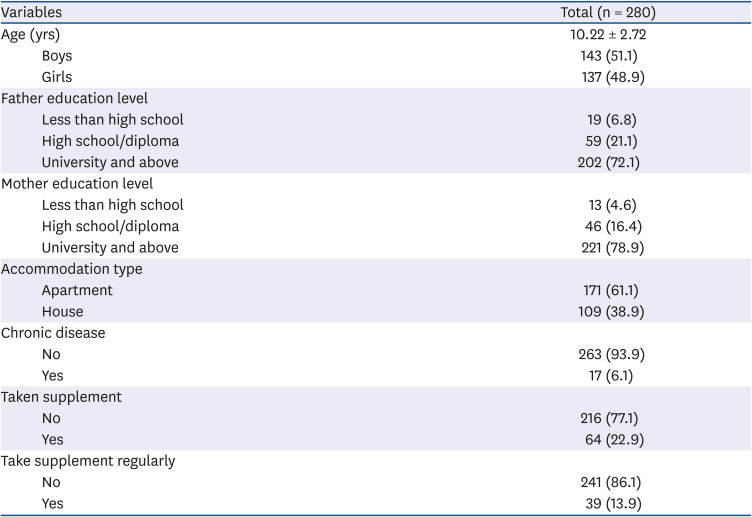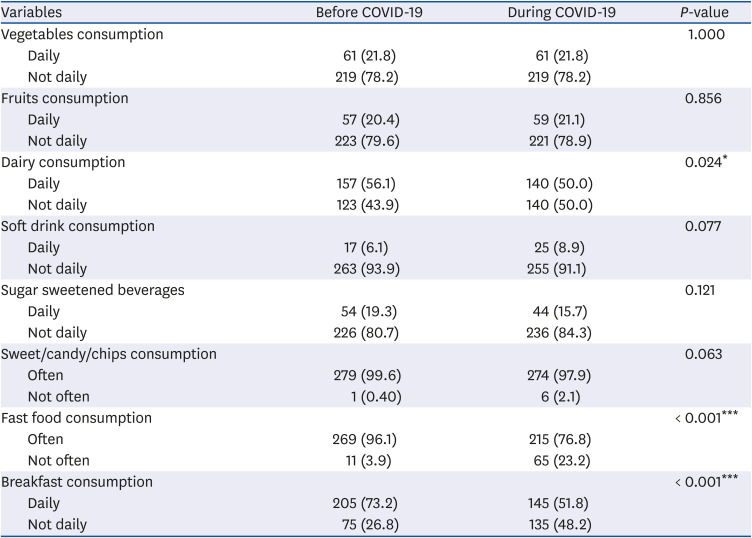2. Orgilés M, Morales A, Delvecchio E, Mazzeschi C, Espada JP. Immediate psychological effects of the COVID-19 quarantine in youth from Italy and Spain. Front Psychol. 2020; 11:579038. PMID:
33240167.

3. Rundle AG, Park Y, Herbstman JB, Kinsey EW, Wang YC. COVID-19-related school closings and risk of weight gain among children. Obesity (Silver Spring). 2020; 28:1008–1009. PMID:
32227671.

4. Buheji M, Hassani A, Ebrahim A, Cunha KC, Jahrami H, Baloshi M, Hubail S. Children and coping during COVID-19: a scoping review of bio-psycho-social factors. Int J Appl Psychol. 2020; 10:8–15.

5. Muscogiuri G, Pugliese G, Barrea L, Savastano S, Colao A. Commentary: obesity: the “Achilles heel” for COVID-19? Metabolism. 2020; 108:154251. PMID:
32353356.

6. Di Renzo L, Gualtieri P, Pivari F, Soldati L, Attinà A, Cinelli G, Leggeri C, Caparello G, Barrea L, Scerbo F, et al. Eating habits and lifestyle changes during COVID-19 lockdown: an Italian survey. J Transl Med. 2020; 18:229. PMID:
32513197.

7. Abbas AM, Fathy SK, Fawzy AT, Salem AS, Shawky MS. The mutual effects of COVID-19 and obesity. Obes Med. 2020; 19:100250. PMID:
32382684.

8. Smethers AD, Rolls BJ. Dietary management of obesity: cornerstones of healthy eating patterns. Med Clin North Am. 2018; 102:107–124. PMID:
29156179.
9. Kimm SYS, Obarzanek E. Childhood obesity: a new pandemic of the new millennium. Pediatrics. 2002; 110:1003–1007. PMID:
12415042.

10. El Mouzan MI, Foster PJ, Al Herbish AS, Al Salloum AA, Al Omer AA, Qurachi MM, Kecojevic T. Prevalence of overweight and obesity in Saudi children and adolescents. Ann Saudi Med. 2010; 30:203–208. PMID:
20427936.

11. McGuire S. Institute of Medicine. 2012. Accelerating progress in obesity prevention: solving the weight of the nation. Washington, DC: the National Academies Press. Adv Nutr. 2012; 3:708–709. PMID:
22983849.

13. Clemmensen C, Petersen MB, Sørensen TI. Will the COVID-19 pandemic worsen the obesity epidemic? Nat Rev Endocrinol. 2020; 16:469–470. PMID:
32641837.

14. Currie C, Roberts C, Morgan A, Smith R, Settertobulte W, Samdal O, Rasmussen VB, editors. Young people's health in context: health behavior in school-aged children (HBSC) study: international report from the 2001/2002 survey. Copenhagen: WHO Regional Office for Europe;2002.
15. Zheng KI, Gao F, Wang XB, Sun QF, Pan KH, Wang TY, Ma HL, Chen YP, Liu WY, George J, et al. Letter to the Editor: obesity as a risk factor for greater severity of COVID-19 in patients with metabolic associated fatty liver disease. Metabolism. 2020; 108:154244. PMID:
32320741.

16. Cai Q, Chen F, Wang T, Luo F, Liu X, Wu Q, He Q, Wang Z, Liu Y, Liu L, et al. Obesity and COVID-19 severity in a designated hospital in Shenzhen, China. Diabetes Care. 2020; 43:1392–1398. PMID:
32409502.

17. Lighter J, Phillips M, Hochman S, Sterling S, Johnson D, Francois F, Stachel A. Obesity in patients younger than 60 years is a risk factor for COVID-19 hospital admission. Clin Infect Dis. 2020; 71:896–897. PMID:
32271368.

18. Petrilli CM, Jones SA, Yang J, Rajagopalan H, O'Donnell L, Chernyak Y, Tobin KA, Cerfolio RJ, Francois F, Horwitz LI. Factors associated with hospitalization and critical illness among 4,103 patients with COVID-19 disease in New York City. medRxiv. 2020.

19. Sattar N, McInnes IB, McMurray JJV. Obesity is a risk factor for severe COVID-19 infection: multiple potential mechanisms. Circulation. 2020; 142:4–6. PMID:
32320270.
20. Simonnet A, Chetboun M, Poissy J, Raverdy V, Noulette J, Duhamel A, Labreuche J, Mathieu D, Pattou F, Jourdain M, et al. High prevalence of obesity in severe acute respiratory syndrome coronavirus-2 (SARS-CoV-2) requiring invasive mechanical ventilation. Obesity (Silver Spring). 2020; 28:1195–1199. PMID:
32271993.

21. Sahoo K, Sahoo B, Choudhury AK, Sofi NY, Kumar R, Bhadoria AS. Childhood obesity: causes and consequences. J Family Med Prim Care. 2015; 4:187–192. PMID:
25949965.
22. Boutelle KN, Peterson CB, Crosby RD, Rydell SA, Zucker N, Harnack L. Overeating phenotypes in overweight and obese children. Appetite. 2014; 76:95–100. PMID:
24524975.

23. Al-Hazzaa HM, Abahussain NA, Al-Sobayel HI, Qahwaji DM, Musaiger AO. Physical activity, sedentary behaviors and dietary habits among Saudi adolescents relative to age, gender and region. Int J Behav Nutr Phys Act. 2011; 8:140. PMID:
22188825.

24. Deschasaux-Tanguy M, Druesne-Pecollo N, Esseddik Y, de Edelenyi FS, Allès B, Andreeva VA, Baudry J, Charreire H, Deschamps V, Egnell M, et al. Diet and physical activity during the COVID-19 lockdown period (March-May 2020): results from the French NutriNet-Sante cohort study. medRxiv. 2020.

25. Bhutani S, Cooper JA. COVID-19-related home confinement in adults: weight gain risks and opportunities. Obesity (Silver Spring). 2020; 28:1576–1577. PMID:
32428295.

26. Husain W, Ashkanani F. Does COVID-19 change dietary habits and lifestyle behaviours in Kuwait: a community-based cross-sectional study. Environ Health Prev Med. 2020; 25:61. PMID:
33045996.

27. Calder PC. Nutrition, immunity and COVID-19. BMJ Nutr Prev Health. 2020; 3:74–92.

28. Kant AK, Graubard BI. Association of self-reported sleep duration with eating behaviors of American adults: NHANES 2005–2010. Am J Clin Nutr. 2014; 100:938–947. PMID:
25057157.

29. Westerlund L, Ray C, Roos E. Associations between sleeping habits and food consumption patterns among 10–11-year-old children in Finland. Br J Nutr. 2009; 102:1531–1537. PMID:
19664303.

30. Alkazemi DUZ, Saleh A. Adequacy of dairy product intake among children in Kuwait using a short dietary assessment questionnaire. Nutr Food Sci. 2019; 49:112–128.

31. Wüenstel JW, Kowalkowska J, Wądołowska L, Słowińska MA, Niedźwiedzka E, Kurp L. Habitual eating of breakfast, consumption frequency of selected food and overweight prevalence in adolescents from various age groups. Dev Period Med. 2015; 19:193–201. PMID:
26384123.
32. Alhilabi HS, Payne A. The impact of skipping breakfast on the body weight of children and young people in Saudi Arabia; a systematic review. Arab J Nutr Exerc. 2018; 3:67–104.

33. Poorolajal J, Sahraei F, Mohamdadi Y, Doosti-Irani A, Moradi L. Behavioral factors influencing childhood obesity: a systematic review and meta-analysis. Obes Res Clin Pract. 2020; 14:109–118. PMID:
32199860.

34. Watanabe Y, Saito I, Henmi I, Yoshimura K, Maruyama K, Yamauchi K, Matsuo T, Kato T, Tanigawa T, Kishida T, et al. Skipping breakfast is correlated with obesity. J Rural Med. 2014; 9:51–58. PMID:
25648986.

35. Carroll N, Sadowski A, Laila A, Hruska V, Nixon M, Ma DWL, Haines J. On Behalf Of The Guelph Family Health Study. The impact of COVID-19 on health behavior, stress, financial and food security among middle to high income Canadian families with young children. Nutrients. 2020; 12:2352.

36. Ruiz-Roso MB, de Carvalho Padilha P, Mantilla-Escalante DC, Ulloa N, Brun P, Acevedo-Correa D, Arantes Ferreira Peres W, Martorell M, Aires MT, de Oliveira Cardoso L, et al. COVID-19 confinement and changes of adolescent's dietary trends in Italy, Spain, Chile, Colombia and Brazil. Nutrients. 2020; 12:1807.

37. Carroll N, Sadowski A, Laila A, Hruska V, Nixon M, Ma DW, Haines J. On Behalf Of The Guelph Family Health Study. The impact of COVID-19 on health behavior, stress, financial and food security among middle to high income Canadian families with young children. Nutrients. 2020; 12:2352.

38. Moore SA, Faulkner G, Rhodes RE, Brussoni M, Chulak-Bozzer T, Ferguson LJ, Mitra R, O'Reilly N, Spence JC, Vanderloo LM, et al. Impact of the COVID-19 virus outbreak on movement and play behaviours of Canadian children and youth: a national survey. Int J Behav Nutr Phys Act. 2020; 17:85. PMID:
32631350.

39. Dunton GF, Do B, Wang SD. Early effects of the COVID-19 pandemic on physical activity and sedentary behavior in children living in the U.S. BMC Public Health. 2020; 20:1351. PMID:
32887592.

40. Stiglic N, Viner RM. Effects of screentime on the health and well-being of children and adolescents: a systematic review of reviews. BMJ Open. 2019; 9:e023191.

41. Margaritis I, Houdart S, El Ouadrhiri Y, Bigard X, Vuillemin A, Duché P. How to deal with COVID-19 epidemic-related lockdown physical inactivity and sedentary increase in youth? Adaptation of Anses' benchmarks. Arch Public Health. 2020; 78:52. PMID:
32514348.

42. Koca T, Akcam M, Serdaroglu F, Dereci S. Breakfast habits, dairy product consumption, physical activity, and their associations with body mass index in children aged 6–18. Eur J Pediatr. 2017; 176:1251–1257. PMID:
28799014.

43. Izeta EG, Plazas M, Zardaín VG, Lizaur AB. Eating habits and physical activity in school children: a comparison before and after summer vacations. J Obes Weight Loss Ther. 2014; 4:223.

44. Pietrobelli A, Pecoraro L, Ferruzzi A, Heo M, Faith M, Zoller T, Antoniazzi F, Piacentini G, Fearnbach SN, Heymsfield SB. Effects of COVID‐19 lockdown on lifestyle behaviors in children with obesity living in Verona, Italy: a longitudinal study. Obesity (Silver Spring). 2020; 28:1382–1385. PMID:
32352652.

46. Chu YL, Farmer A, Fung C, Kuhle S, Storey KE, Veugelers PJ. Involvement in home meal preparation is associated with food preference and self-efficacy among Canadian children. Public Health Nutr. 2013; 16:108–112. PMID:
22578854.

47. Muscogiuri G, Barrea L, Savastano S, Colao A. Nutritional recommendations for COVID-19 quarantine. Eur J Clin Nutr. 2020; 74:850–851. PMID:
32286533.

48. Abbas AM, Kamel MM. Dietary habits in adults during quarantine in the context of COVID-19 pandemic. Obes Med. 2020; 19:100254. PMID:
32427142.










 PDF
PDF Citation
Citation Print
Print



 XML Download
XML Download